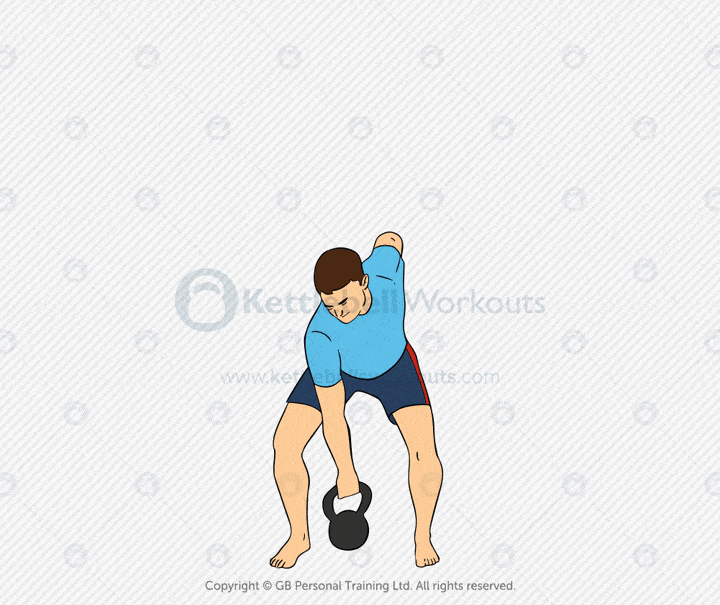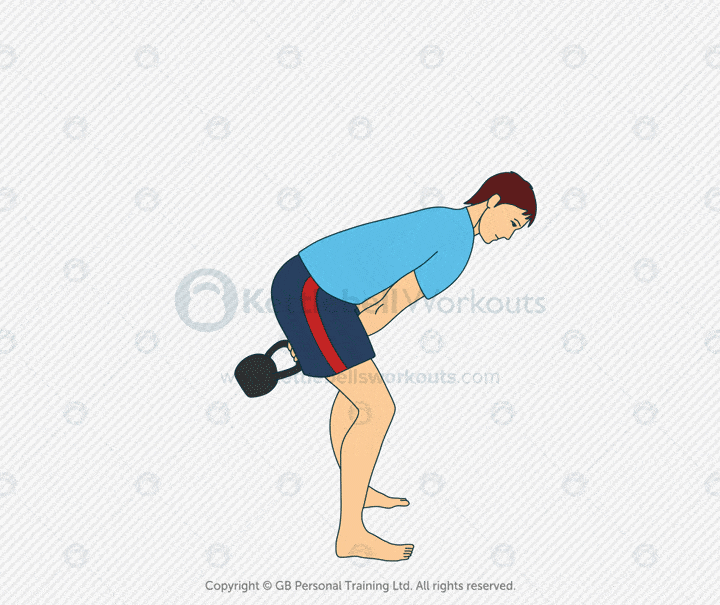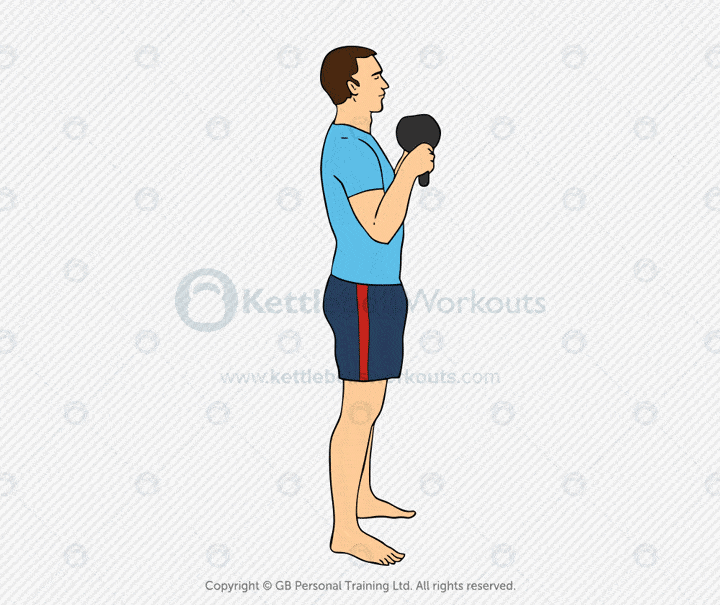Last Updated on 4 July 2025 by Greg Brookes
One of my favourite ways to programme kettlebell workouts is using ladder formats. Ladder workouts are simple yet highly effective for building strength, power, and conditioning while keeping training engaging.
I’ve used kettlebell ladder workouts with clients for over 15 years to increase volume safely, build progressive overload, and keep motivation high by giving clear short-term targets to focus on.
Kettlebell ladder workouts are highly effective because you can soon build up a substantial amount of reps without realising it. The short rest periods in between each set of reps help you get through the next set and also seem to upregulate your strength system enabling you to lift heavier.
In this article, I’ll explain what ladder workouts are, the different types you can use, their benefits, and share sample kettlebell ladder workouts including movement ladders, where you add another exercise each round for a full-body challenge.
What Is a Kettlebell Ladder Workout
A kettlebell ladder workout involves gradually increasing or decreasing reps each set. For example, performing 1 rep, then 2 reps, then 3 reps, up to 5 reps, then starting over or descending back down.
Ascending Ladders
These involve starting with a low rep number and increasing each set. For example:
- 1 rep
- 2 reps
- 3 reps
- 4 reps
- 5 reps
Once you reach the top, you can either:
- Start again from the bottom
- Descend back down (creating a pyramid ladder)
Descending Ladders
Here you start with higher reps and decrease each set. For example:
- 10 reps
- 8 reps
- 6 reps
- 4 reps
- 2 reps
Descending ladders work well for high volume movements where technique fatigue is a concern, allowing you to maintain quality as reps decrease.
Double Ladders
These combine two ladders within one workout. For example:
- 1 rep (left), 1 rep (right)
- 2 reps (left), 2 reps (right)
- 3 reps (left), 3 reps (right)
- 4 reps (left), 4 reps (right)
- 5 reps (left), 5 reps (right)
Double ladders are excellent for unilateral exercises like cleans, presses, or snatches.
Movement Ladders
A movement ladder involves adding another exercise each round, creating a flowing circuit that builds complexity, endurance, and full-body challenge.
For example:
- Round 1: Swing x 10
- Round 2: Swing x 10, Goblet Squat x 10
- Round 3: Swing x 10, Goblet Squat x 10, Clean and Press x 5 each side
- Round 4: Swing x 10, Goblet Squat x 10, Clean and Press x 5 each side, Reverse Lunge x 5 each side
These work beautifully for metabolic conditioning while practising exercise transitions efficiently.

Benefits of Kettlebell Ladder Workouts
Here’s why kettlebell ladders are a staple in my programming:
- Build progressive overload safely. Increase reps gradually without technique breakdown.
- Develop strength endurance. Accumulate high volume effectively.
- Improve focus and motivation. Short-term targets keep you engaged.
- Enhance skill and technique. Frequent practice with structured reps reinforces patterns.
- Conditioning and fat loss. Ladder circuits elevate heart rate and keep workouts time-efficient.
Programming Tips for Ladder Workouts
Here’s how I approach ladder programming:
- Choose an appropriate exercise. Swings, squats, cleans, lunges, presses, and snatches work best.
- Decide on rep range. 1–5 or 1–10 ladders are common. Adjust based on load and movement complexity.
- Use ladders for strength or conditioning. Lower rep ladders (1–5) build strength, higher reps (up to 20) build muscular endurance and conditioning.
- Maintain technique throughout. Never sacrifice form to finish a ladder.
- Combine with rest strategically. Rest as needed between rungs to maintain power output.
- Movement ladders: Choose different movement pattern exercises that flow naturally to reduce transitions and keep intensity high.
Sample Kettlebell Ladder Workouts
1. Clean and Press Strength Ladder
Format: Ascending ladder 1–5 reps each side x 3 ladders
- Clean and Press Left x 1 rep
- Clean and Press Right x 1 rep
- Clean and Press Left x 2 reps
- Clean and Press Right x 2 reps
- Continue to 5 reps each side
Rest 60 seconds then repeat for two more ladders.
Why it works: Builds pressing volume safely while reinforcing clean technique under fatigue.

2. Swing Conditioning Descending Ladder
Format: Descending ladder 10–1 reps
- Two-Handed Swing x 10 reps
- Rest 20 seconds
- Two-Handed Swing x 9 reps
- Rest 20 seconds
Continue down to 1 rep.
Why it works: High-volume hip hinge conditioning with short rests to maintain heart rate and power output.

3. Movement Ladder Circuit
Format: Add an exercise each round
- Round 1: Swings x 10
- Round 2: Swings x 10, Goblet Squats x 10
- Round 3: Swings x 10, Goblet Squats x 10, Clean and Press x 5 each side
- Round 4: Swings x 10, Goblet Squats x 10, Clean and Press x 5 each side, Reverse Lunges x 5 each side
Rest as needed between rounds.
Why it works: Builds full-body conditioning and muscular endurance while challenging coordination and exercise transitions.

Coach’s Insight: Greg’s Take
Kettlebell ladders are one of my favourite ways to structure training. They teach pacing, reinforce technique, and build strength and conditioning efficiently.
I particularly love movement ladders for clients who get bored easily. They create variety while ensuring the workout gets progressively harder, keeping motivation high.
Remember, quality always trumps quantity. Choose a rep ladder you can complete with excellent form from start to finish.
Final Thoughts
Kettlebell ladder workouts are a powerful tool to build strength, muscular endurance, and conditioning efficiently. Whether using ascending ladders for pressing strength, descending ladders for conditioning, or movement ladders for full-body challenges, ladders keep your training structured, progressive, and engaging.
Add them into your programme this week to experience their benefits first-hand, and explore other kettlebell workout formats such as EMOM, AMRAP, circuits, flows, complexes, Tabata, intervals, and WODs to keep your training varied and effective.
Want to explore all kettlebell workout styles? Check out my complete Kettlebell Workout Formats Guide to find the best format for your goals.
Frequently Asked Questions
A structured workout where reps increase or decrease each set to build volume, strength, or conditioning.
Yes, starting with low reps and building up helps reinforce technique while avoiding fatigue breakdown.
Choose a weight you can move with crisp technique for your top rep set.
Absolutely. Higher-rep ladders or movement ladders elevate heart rate effectively.
Ladders ascend or descend reps; pyramids combine both into one structure.



Hi Greg, I did ladder for fat loss yesterday, awesome
How long is the rest period between the ladder reps for mass and the rest periods between the sets cheers Scott
Usually around 1-1.5 for mass and 2-3 minutes for strength Scott.
Hi greg while doing the ladder reps for mass could you recommend any kettlebell excersisis for adding mass to the chest
Hello Scott, kettlebells are not the correct tool for adding mass to the chest, I’d work on push ups or single arm push ups instead. You will get chest activation from many of the pushing kettlebell exercises but they are not optimal for mass.
Greg: if I were to add a squat to the fat loss routine and still keep the swing in the routine, what would you suggest for a sequence?
Mike, you could replace the overhead press with the thruster (squat and press) that way you still only have to perform 3 exercises 🙂